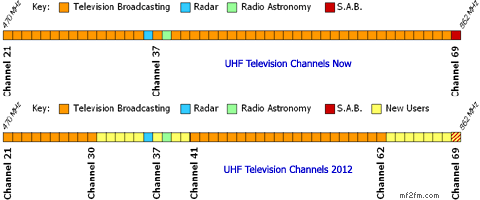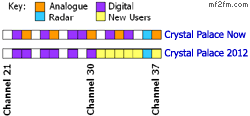Wednesday 20 September, 2006, 12:08 - Licensed
 As anyone who has bought a new television in the UK in the past year or so will know, it is the Government's intention to close down all analogue TV transmitters by the end of the year 2012. It's main reason for doing this is to release some of the channels used for broadcasting so that they can be used for 'new users' (presumably ones that they see as being more lucrative!)
As anyone who has bought a new television in the UK in the past year or so will know, it is the Government's intention to close down all analogue TV transmitters by the end of the year 2012. It's main reason for doing this is to release some of the channels used for broadcasting so that they can be used for 'new users' (presumably ones that they see as being more lucrative!)The plan is for a rolling conversion of all television transmitters in the country to change from analogue to digital. In doing this, of the four existing analogue frequencies used to carry BBC1, BBC2, ITV1 and Channel 4, only three of these will continue to be used - one will be freed for the aforementioned mysterious new users. The three frequencies still in use will carry three digital mulitplexes ensuring national provision of all BBC, ITV, Channel 4 services including CBBC, BBC News 24, ITV2, ITV3, E4 and so on, so there's no need to worry about people losing their favourite programmes. At the 80 transmitter sites that already carry digital services of the 4 (or 5) analogue frequencies in use and the 6 digital frequencies in use, only 6 will remain in use, the remainder falling into the pot of those available for other users.
Once the digital switch-over (as it's know) is complete, only UHF channels 21 to 30 and 41 to 62 will still be available for television broadcasting. Channels 31 to 40 and 63 to 68 (and possibly 69) will be freed for new users. The diagram below illustrates this situation. 'S.A.B.' represents services ancilliary to broadcasting (sometimes known as programme making and special events) and includes radiomicrophones, talkback, remote control for cameras, point-to-point audio links - i.e. radio equipment used by people making programmes. Channel 69 is shown hashed as it's not yet clear whether or not it will be given over to new users or remain with S.A.B.

So how can the necessary channels be crammed into two-thirds of the original spectrum? There are now approximately 5,200 individual television transmitters on-air in the UK amounting to around 115 transmitters per available UHF TV channel. After switch-over the number of transmitters will be reduced to around 3,800 - but this has to be squeezed into only 32 channels amounting to around 118 transmitters per channel. So the number of transmitters per channel remains roughly the same, and therefore, in theory, planning the new network should be no more difficult than planning the old one was.
 Let's take a look at a practical example, using the Crystal Palace television transmitter site which serves around 12 million people in and around London. At present channels 23, 26, 30, 33 and 37 are used for analogue transmissions and channels 22, 25, 28, 29, 32 and 34 are used for digital. Of these, channels 32, 33, 34 and 37 will no longer be available for broadcasting after switch-over as they are part of the channels set aside for new users.
Let's take a look at a practical example, using the Crystal Palace television transmitter site which serves around 12 million people in and around London. At present channels 23, 26, 30, 33 and 37 are used for analogue transmissions and channels 22, 25, 28, 29, 32 and 34 are used for digital. Of these, channels 32, 33, 34 and 37 will no longer be available for broadcasting after switch-over as they are part of the channels set aside for new users. So after switch-over, a combination of the existing analogue and digital channels (i.e. channels 22, 23, 25, 26, 28 and 30) will be used for the purely digital service. Thus the future all-digital transmissions can be squeezed into the remaining broadcasting channels at this particular transmitter site.
 This situation is also fine at the majority of UK transmitter sites including the smaller ones as typically at least 3 of the 4 channels in use at these smaller sites will fall within the untouched broadcast spectrum. Some jiggery-pokery will be necessary at a small number of sites to squash services into the remaining channels but all-in-all the plan works!
This situation is also fine at the majority of UK transmitter sites including the smaller ones as typically at least 3 of the 4 channels in use at these smaller sites will fall within the untouched broadcast spectrum. Some jiggery-pokery will be necessary at a small number of sites to squash services into the remaining channels but all-in-all the plan works!The question remains as to what 'new uses' might be made of the freed spectrum. One possiblity is that it might be used for more digital television (maybe mobile TV, portable TV or HD-TV). It might be used for more celluar services (maybe 4G). It might be used for mobile delivery of wireless broadband (maybe using 802.20). Some of it might be needed to house all the displaced S.A.B. users who currently occupy channel 69 (and to a lesser extent also heavily occupy channels 63 to 68). At present it's anyone's guess as to the need for and use of this spectrum but one thing is for certain, the UK Government will be rubbing their hands together in glee at the potential for raising a pot of gold for selling it.
add comment
( 1220 views )
| permalink
| 



 ( 1.9 / 278 )
( 1.9 / 278 )




 ( 1.9 / 278 )
( 1.9 / 278 )

